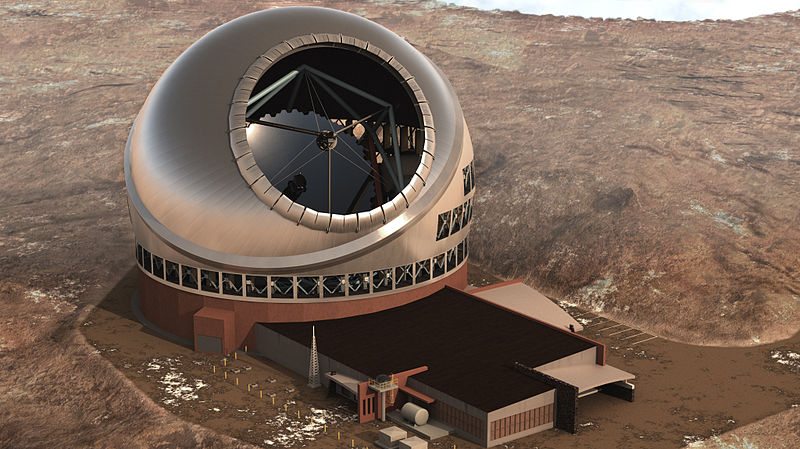
Scientists, astronomers, and amateur stargazers are all abuzz – or soon will be. On Friday, the Hawaii Board of Land and Natural Resources granted a permit for the Thirty Meter Telescope (TMT) project to be built atop Mauna Kea on the Island of Hawaii. The TMT promises to let us explore the galaxy’s origins, allow the analysis of black holes, and learn more about the formation of planets and stars. And according to the TMT website:
Observations with TMT will help answer questions about the early production and dispersal of the chemical elements, the distribution of baryons within dark matter halos and the processes of hierarchical merging of subgalactic fragments.
The planned Thirty Meter Telescope will cover 1.44 acres (though the “area of disturbance” will be closer to five acres) and soar 18 stories high. The diameter of the primary mirror will be 30 meters, thus the name of the telescope. Currently, the mountaintop is home to 12 different observatories; the largest optical telescope is the 10-meter W. M. Keck Observatory standing at roughly eight stories high. Construction on the new Thirty Meter Telescope is expected to begin in April, 2014 at a cost of more than one billion dollars. Scientific operations should begin in 2021.

Literally translated, Mauna Kea means white mountain; winter months see the peaks capped with snow. It’s a harsh environment year-round, though. The air is thin and visitors are strongly cautioned about visiting the summit. Observatory employees use oxygen tanks to help them cope with the conditions and arrange their shifts to lessen the health impact of working at high altitudes. Even so, Mauna Kea’s elevation of 13,796′ above sea level coupled with the remoteness of the islands offers ideal viewing conditions for astronomers. There’s very little light pollution to interfere with viewing the night sky. (In fact, street lights on the island are an amber color to keep light pollution at a minimum.)
There’s no question; the TMT will substantially increase scientists’ ability to explore our universe. But the project is a contentious one. Mauna Kea – or Mauna a Wākea as the Native Hawaiians called it – is a sacred site. According to Kahea:
It is home of Na Akua (the Divine Deities), Na `Aumakua (the Divine Ancestors), and the meeting place of Papa (Earth Mother) and Wākea (Sky Father) who are considered the progenitors of the Hawaiian People. Mauna Kea, it is said, is where the Sky and Earth separated to form the Great-Expanse-of-Space and the Heavenly Realms. Mauna Kea in every respect represents the zenith of the Native Hawaiian people’s ancestral ties to Creation itself.
Cultural practitioners perform ceremonies on the mountaintop and make offerings to spiritual ancestors. They chant, honoring the mountain. They worship. The entire mountain is essentially a sacred outdoor temple to the Hawaiian people. Imagine, if you will, a giant telescope mounted atop the Vatican. Or Salt Lake Temple. Or Stonehenge. Oh, the uproar!

While the scientific community celebrates, a group of native people mourns the planned desecration of one of their most sacred sites. The desires of this indigenous group of people have been ignored in the name of progress, but they continue to fight against the project. After hearing about the ruling, Pua Case, one of the petitioners against the TMT, wrote on her Facebook wall:
Do not be in despair or anger… this will provide the opportunity for us all to stand together for the highest temple in the world from sea level and for the good of all we stand… stand with us Hawaiʻi and beyond.
Will this project change history? In one or two hundred years will we be emigrating to a habitable planet discovered by the TMT to start anew? Will we look back, aghast at our easy dismissal of a culture and its history? How can we, with our burning desire for more knowledge, accomodate both culture and science?
Hawaii residents seem to be either strongly in favor of the telescope project or strongly opposed to it, but despite the recent ruling, we still don’t know how this particular story ends.




